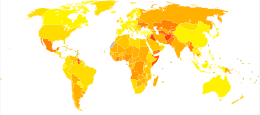先天性障碍
| 先天性障碍 | |
|---|---|
| 又称 | 先天性疾病、畸形[1] |
 | |
| 一位患有唐氏症的小孩,该症是最常见的先天性障碍之一[2] | |
| 症状 | 身体障碍, 智能障碍, 发展迟缓[3] |
| 起病年龄 | 出生时[3] |
| 类型 | 结构性、功能性[4] |
| 病因 | 基因突变、暴露在特定的化学物中、孕期中受感染[5] |
| 风险因素 | 叶酸缺乏症、怀孕时饮酒或是吸烟、妊娠糖尿病控制不当、孕妇年龄超过35岁[6] |
| 治疗 | 治疗、药物、手术、辅助技术][7] |
| 患病率 | 3%的新生儿(美国)[2] |
| 死亡数 | 628,000人(2015年,美国)[8] |
| 分类和外部资源 | |
| 医学专科 | 遗传学, 儿医学 |
| ICD-11 | XB8M |
| DiseasesDB | 28811 |
先天性障碍(congenital disorder)又称出生缺陷[9](birth defect)、先天缺陷[10](congenital defect)[11],视情况有时称先天性疾病、先天畸形,是指发育中的胎儿因为遗传性疾病或发育环境等因素导致某部位特征、结构、功能的异常,导致在婴儿出生时即有的病症[3],包括了身体、智能以及发展上的障碍[3]。障碍程度可能轻微,也可能严重[12]。先天性障碍可以分为二类:结构性缺陷是指身体器官或部位在外形或是结构上的缺陷,而功能性缺陷是指身体部位在功能上的缺陷[4]。功能性缺陷包括代谢疾病及退行性疾病[4]。有些先天性障碍则同时包括了结构性缺陷以及功能性缺陷二者[4]。
先天性障碍可能是因为遗传疾病、染色体畸变,或是怀孕时暴露在特定化学物质、服用特定药物或是怀孕时感染[5]。风险因子包括叶酸缺乏症、怀孕时饮酒或是吸烟、妊娠糖尿病控制不当、或是孕妇年龄超过35岁[6][12]。许多先天性障碍可能是因为多种原因造成[12]。先天性障碍可能是婴儿出生时即可看出的,也有些是透过新生儿筛检得知[13]。许多的先天性障碍可以在怀孕时在产前诊断检查出来[13]。
根据动物实验,发育中的胎儿所得到的营养取决于父母的进食,也有可能对胎儿出生以后长期影响到他的生活型态[14]。也动物实验也指出,父母的思维、生活作息也会影响到胎儿的发育过程,由实验可知,父亲如果整天酗酒、少吃蔬果类的食物、吸烟、吸毒品等不良行为,更容易让胎儿造成基因突变而导致先天性障碍[15][16][17][18]。
先天性障碍的处理方式因种类而有所不同[7],包括有治疗、药物、手术以及辅助技术[7]。在2015年有9600万人有先天性障碍[19] 。在美国有3%的新生儿有先天性障碍[2] ,在1990年时全世界因先天性障碍死亡的人数有75.1万人,到2015年降到62.8万人[20][8]。主要的死因有先天性心脏病(30.3万人)及神经管缺陷(6.5万人)[8]。
部分先天性障碍的举例
[编辑]
- 先天性水痘症候群:患者的皮肤常因色素沈著而黝黑。
- 先天性遗传多毛症:出生不久之后全身上下长满了乌黑而坚硬的毛。
- 先天性横膈疝气:限制肺部生长。
- 地中海贫血:不能有效地制造红血球,其带氧能力亦不足。
- 根达综合症:酵素或尿卟啉原Ⅲ共合成酶不足。
- 先天性脑积水:包围著脑部与脊髓的脑脊液异常增加或累积,导致颅内压异常增加的情形。
- 先天性碘缺乏症候群:严重阻碍身心发展。
- 胎儿酒精综合症:母亲在怀孕期间的酒精消耗量可能会引起各种先天性障碍的长期连续性:颅面畸形[21]、脑的损伤[22]、智能障碍[23]、心脏病、肾功能异常、骨骼异常、双眼异常[24]等。在美国,受影响儿童的患病率估计至少有1%[25],在加拿大也是如此。
- 苗勒管发育不全、先天性无子宫、先天性无阴道:妇科先天缺陷。
数据与分布图
[编辑]
从1990年至2013年期间数据统计显示:每年因先天性疾病导致死亡者从751,000人降至632,000人[20],其中先天性心脏疾病导致死亡的人数最多(323000人),其次是神经管异常(69000人)[20]。
参考文献
[编辑]- ^ Ruth A. Hannon. Porth pathophysiology : concepts of altered health states 1st Canadian. Philadelphia, PA: Wolters Kluwer Health/Lippincott Williams & Wilkins. 2010: 128 [2018-05-07]. ISBN 978-1-60547-781-7. (原始内容存档于2017-08-20).
- ^ 2.0 2.1 2.2 Birth Defects. Dec 15, 2015 [17 Jan 2016]. (原始内容存档于2018-06-18).
- ^ 3.0 3.1 3.2 3.3 Birth Defects: Condition Information. www.nichd.nih.gov. [8 December 2017]. (原始内容存档于2017-12-22).
- ^ 4.0 4.1 4.2 4.3 What are the types of birth defects?. www.nichd.nih.gov. [8 December 2017]. (原始内容存档于2017-12-22).
- ^ 5.0 5.1 What causes birth defects?. www.nichd.nih.gov. [8 December 2017]. (原始内容存档于2017-12-17).
- ^ 6.0 6.1 How many people are affected by/at risk for birth defects?. www.nichd.nih.gov. [8 December 2017]. (原始内容存档于2017-12-17).
- ^ 7.0 7.1 7.2 What are the treatments for birth defects?. www.nichd.nih.gov. [8 December 2017]. (原始内容存档于2017-12-20).
- ^ 8.0 8.1 8.2 GBD 2015 Mortality and Causes of Death, Collaborators. Global, regional, and national life expectancy, all-cause mortality, and cause-specific mortality for 249 causes of death, 1980-2015: a systematic analysis for the Global Burden of Disease Study 2015.. Lancet. 8 October 2016, 388 (10053): 1459–1544. PMC 5388903
 . PMID 27733281. doi:10.1016/s0140-6736(16)31012-1.
. PMID 27733281. doi:10.1016/s0140-6736(16)31012-1.
- ^ 存档副本. [2024-02-06]. (原始内容存档于2024-02-06).
- ^ https://terms.naer.edu.tw/search/?csrfmiddlewaretoken=t4rEKuzQntvvh1eIIgmA2g6tIrjQQjVesPR5DNVQNslfXUzTkqh9sK2DiJ8ZNW4T&match_type=phrase&query_op=&query_field=title&query_term=congenital+defect
- ^ Ruth A. Hannon. Porth pathophysiology : concepts of altered health states 1st Canadian ed. Philadelphia, PA: Wolters Kluwer Health/Lippincott Williams & Wilkins. 2010: 128 [2015-07-04]. ISBN 9781605477817. (原始内容存档于2015-07-03).
- ^ 12.0 12.1 12.2 Facts Birth Defects. Centers for Disease Control and Prevention. 7 September 2017 [8 December 2017]. (原始内容存档于2018-06-15) (美国英语).
- ^ 13.0 13.1 How do health care providers diagnose birth defects?. www.nichd.nih.gov. [8 December 2017]. (原始内容存档于2017-12-22).
- ^ Gregory W. Rutecki. Pre-Prenatal Care: A Primary Care Primer on the Future. ConsultantLive.com. 2010 [25 September 2010]. (原始内容存档于2012-11-09).
- ^ Abel, E. L. Paternal contribution to fetal alcohol syndrome. Addiction Biology. 2004, 9 (2): 127–133. PMID 15223537. doi:10.1080/13556210410001716980.
- ^ De Santis, Marco; Cesari, Elena; Cavaliere, Annafranca; Ligato, Maria Serena; Nobili, Elena; Visconti, Daniela; Caruso, Alessandro. Paternal exposure and counselling: Experience of a Teratology Information Service. Reproductive Toxicology. September 2008, 26 (1): 42–46. PMID 18598753. doi:10.1016/j.reprotox.2008.06.003.
- ^ Sartorius, G. A.; Nieschlag, E. Paternal age and reproduction. Human Reproduction Update. 20 August 2009, 16 (1): 65–79. PMID 19696093. doi:10.1093/humupd/dmp027.
- ^ Anderson, Diana; Schmid, ThomasE; Baumgartner, Adolf. Male-mediated developmental toxicity. Asian Journal of Andrology. 2014, 16 (1): 81. PMID 24369136. doi:10.4103/1008-682X.122342.
- ^ GBD 2015 Disease and Injury Incidence and Prevalence, Collaborators. Global, regional, and national incidence, prevalence, and years lived with disability for 310 diseases and injuries, 1990-2015: a systematic analysis for the Global Burden of Disease Study 2015.. Lancet. 8 October 2016, 388 (10053): 1545–1602. PMC 5055577
 . PMID 27733282. doi:10.1016/S0140-6736(16)31678-6.
. PMID 27733282. doi:10.1016/S0140-6736(16)31678-6.
- ^ 20.0 20.1 20.2 GBD 2013 Mortality and Causes of Death, Collaborators. Global, regional, and national age-sex specific all-cause and cause-specific mortality for 240 causes of death, 1990–2013: a systematic analysis for the Global Burden of Disease Study 2013.. Lancet. 17 December 2014, 385 (9963): 117–71. PMC 4340604
 . PMID 25530442. doi:10.1016/S0140-6736(14)61682-2.
. PMID 25530442. doi:10.1016/S0140-6736(14)61682-2.
- ^ Jones K, Smith D (1975). "The fetal alcohol syndrome". Teratology 12 (1): 1–10. doi:10.1002/tera.1420120102. PMID 1162620.
- ^ Clarren S, Alvord E, Sumi S, Streissguth A, Smith D (1978). "Brain malformations related to prenatal exposure to ethanol". J Pediatr 92 (1): 64–7. doi:10.1016/S0022-3476(78)80072-9. PMID 619080.
- ^ Lancet. 1986 Nov 22;2(8517):1222. PMID 2877359
- ^ Strömland K, Pinazo-Durán M (2002). "Ophthalmic involvement in the fetal alcohol syndrome: clinical and animal model studies". Alcohol Alcohol 37 (1): 2–8. doi:10.1093/alcalc/37.1.2. PMID 11825849.
- ^ May, PA.; Gossage, JP. (2001). "Estimating the prevalence of fetal alcohol syndrome. A summary.". Alcohol Res Health 25 (3): 159–67. PMID 11810953.
- ^ WHO Disease and injury country estimates. World Health Organization. 2009 [Nov 11, 2009]. (原始内容存档于2014-02-11).
